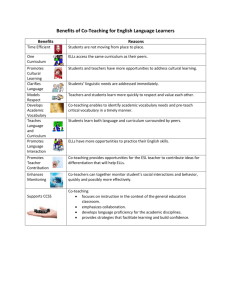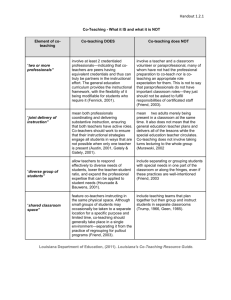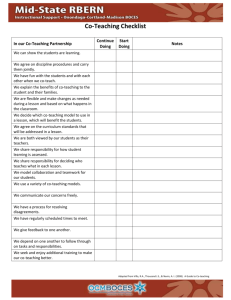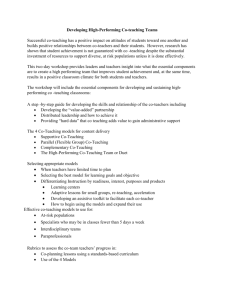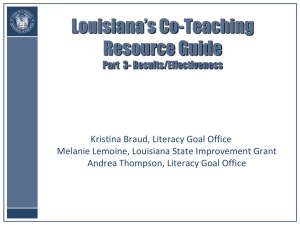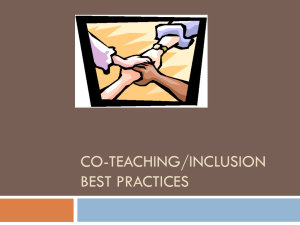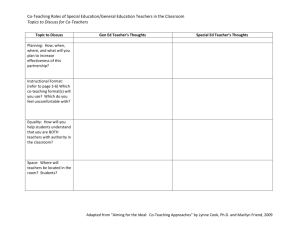Coplanning - Baltimore City Public School System
advertisement
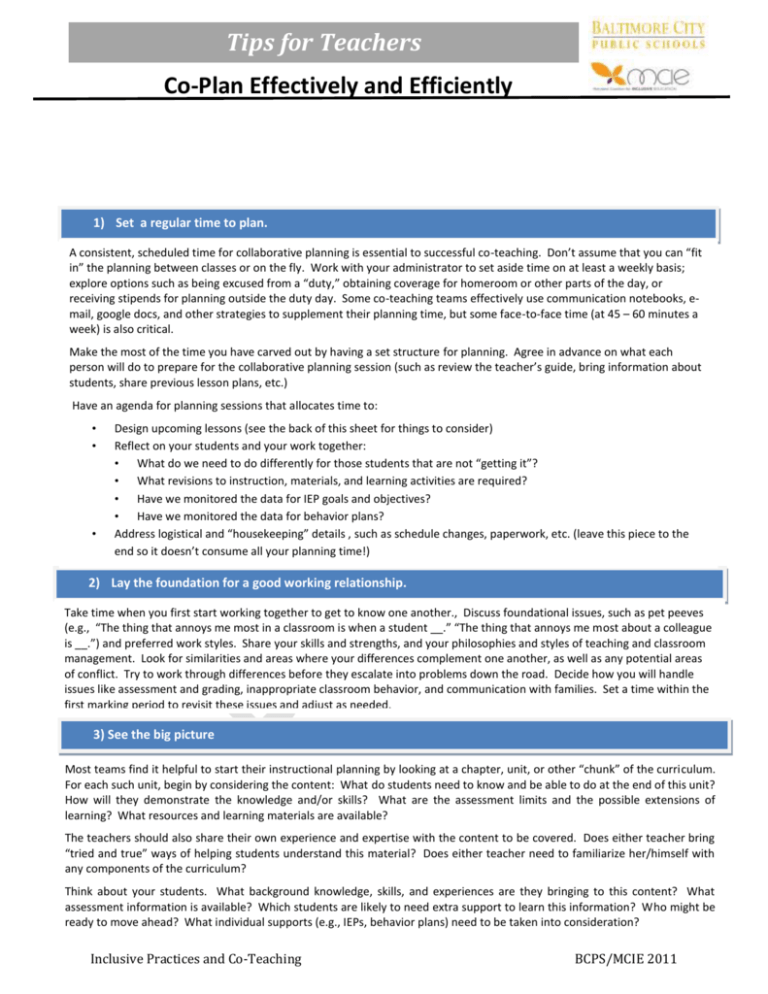
Tips for Teachers Co-Plan Effectively and Efficiently 1) Set a regular time to plan. A consistent, scheduled time for collaborative planning is essential to successful co-teaching. Don’t assume that you can “fit in” the planning between classes or on the fly. Work with your administrator to set aside time on at least a weekly basis; explore options such as being excused from a “duty,” obtaining coverage for homeroom or other parts of the day, or receiving stipends for planning outside the duty day. Some co-teaching teams effectively use communication notebooks, email, google docs, and other strategies to supplement their planning time, but some face-to-face time (at 45 – 60 minutes a week) is also critical. Make the most of the time you have carved out by having a set structure for planning. Agree in advance on what each person will do to prepare for the collaborative planning session (such as review the teacher’s guide, bring information about students, share previous lesson plans, etc.) Have an agenda for planning sessions that allocates time to: • • • Design upcoming lessons (see the back of this sheet for things to consider) Reflect on your students and your work together: • What do we need to do differently for those students that are not “getting it”? • What revisions to instruction, materials, and learning activities are required? • Have we monitored the data for IEP goals and objectives? • Have we monitored the data for behavior plans? Address logistical and “housekeeping” details , such as schedule changes, paperwork, etc. (leave this piece to the end so it doesn’t consume all your planning time!) 2) Lay the foundation for a good working relationship. Take time when you first start working together to get to know one another., Discuss foundational issues, such as pet peeves (e.g., “The thing that annoys me most in a classroom is when a student __.” “The thing that annoys me most about a colleague is __.”) and preferred work styles. Share your skills and strengths, and your philosophies and styles of teaching and classroom management. Look for similarities and areas where your differences complement one another, as well as any potential areas of conflict. Try to work through differences before they escalate into problems down the road. Decide how you will handle issues like assessment and grading, inappropriate classroom behavior, and communication with families. Set a time within the first marking period to revisit these issues and adjust as needed. 3) See the big picture Most teams find it helpful to start their instructional planning by looking at a chapter, unit, or other “chunk” of the curriculum. For each such unit, begin by considering the content: What do students need to know and be able to do at the end of this unit? How will they demonstrate the knowledge and/or skills? What are the assessment limits and the possible extensions of learning? What resources and learning materials are available? The teachers should also share their own experience and expertise with the content to be covered. Does either teacher bring “tried and true” ways of helping students understand this material? Does either teacher need to familiarize her/himself with any components of the curriculum? Think about your students. What background knowledge, skills, and experiences are they bringing to this content? What assessment information is available? Which students are likely to need extra support to learn this information? Who might be ready to move ahead? What individual supports (e.g., IEPs, behavior plans) need to be taken into consideration? Inclusive Practices and Co-Teaching BCPS/MCIE 2011 Co-Plan Effectively and Efficiently 4) Plan for daily instruction Once you have established the overall goals for the unit, begin designing daily instructional activities that will move students toward the targets. For each day’s lessons, determine: 1) What activities and groupings will we use? Having a variety of whole group, small group, partner, and individual activities helps maintain student engagement and promote learning. Vary the groupings by dividing students by skill, interest, preference, etc.) 2) How will we share the instruction? Select a co-teaching structure for each part of the lesson (you may use more than one in a given class period, depending on the content and your students’ needs): One Teach, One Assist. In this approach, one person teaches the whole group while the other professional circulates through the room providing unobtrusive assistance to students as needed. The circulating teacher can also collect detailed observations of students engaged in the learning process. Co-teachers should decide in advance what specific behavior to gather during instruction and analyze the information together Parallel Teaching. Each teacher teaches the same information simultaneously to half the class. Student learning is greatly facilitated by having more supervision by the teacher and more opportunities to respond. Station Teaching. In this co-teaching approach, teachers divide content and students. Each teacher then teaches the content to one group and subsequently repeats the instruction for the other group. If appropriate, a third station where students work independently can be added. Alternative Teaching. In most class groups, occasions arise in which several students need specialized attention. In alternative teaching, one teacher takes responsibility for the large group while the other works with a smaller group providing remediation or enrichment. Team Teaching. In team teaching, the teachers share responsibility for teaching the whole group. Some teachers refer to this as having “one brain in two bodies.” Others call it “tag team teaching.” Most co-teachers consider this approach the most complex but satisfying way to co-teach, but the approach that is most dependent on teachers’ styles. 3) How will we meet individual needs? Consider which of your students may need pre-teaching of vocabulary or concepts, help building background knowledge, alternative ways to access information, or other supports. Make sure to account for any accommodations or modifications needed by students in the class. 4) How will we know if students are learning? Plan for ongoing formative assessment during and at the end of individual activities or lessons, as well as summative assessments and graded products at the end of the unit. Be sure to review the formative assessments and adjust your instruction accordingly. 5) Who will do what? Decide who will provide instruction on what part of the content, as well as who will prepare which materials, create assessments, etc. Leave the planning session with roles and responsibilities clearly determined. This process may seem daunting and time-consuming, and at first it is! However, it is essential – effective co-teaching can not occur without effective planning. As you get to know one another and the students, it gets easier. Experienced co-teaching teams where both members know the content well can plan a daily lesson in about 10 minutes of collaborative time. For more information: Friend & Cook (2004). Co-Teaching: Principles, Practices, and Pragmatics. New Mexico Public Education Department Quarterly Special Education Meeting; K8 Access Center (2007). Improving Access for Students with Disabilities through Collaborative Teaching, retrieved in Jan. 2011 from http://www.k8accesscenter.org/index.php/category/co-teaching/ The Maryland State Department of Education Co-Teaching Network has produced a variety of tools for schools and teachers implementing co-teaching. They are available on the Maryland Learning Links Website, in the Teaching All Students channel www.marylandlearninglinks.org Inclusive Practices and Co-Teaching BCPS/MCIE 2011
